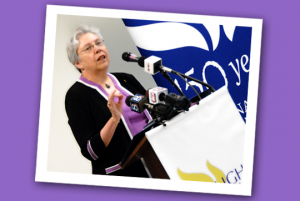Currents interviews Winona State’s departing president, Dr. Judith A. Ramaley.
In her address to open the 2011-12 academic year, Dr. Judith A. Ramaley announced that she was stepping down after seven years as Winona State University’s president.
Ramaley, the university’s fourteenth president, began her service on July 18, 2005. Prior to coming to Winona State, she built a long and influential career as a professor of biology, academic leader, and higher education policy expert. She previously served as president at Portland State University (1990-97) and the University of Vermont (1997-2001).
To begin its interview, Currents looked back to its Spring 2005 issue when the magazine sat down with Ramaley after her first week in the president’s office.
In your first interview with Currents, you identified the “chance to learn” as the thing you most looked forward to. What have you learned in your seven years as president?
My own pattern, when I got here, was excitement about ideas and creative ways to look at the world and respond to it. There was a challenge in getting to know an institution with such a strong sense of place, which Winona State has. I learned that it’s not just about ideas and policies and structure. It’s about people and what they care about, how they’re connected to each other. It’s about learning how to care on a different level. And it’s been good for me.
What surprised you in your early days here?
I grew up as the only child of only children. We moved a lot. I never lived anywhere long enough to learn from and develop close relationships with my classmates, my teachers, or the neighbors. What surprised me most, and then became one of its most cherished attributes, is how personal Winona State is. How you interact, the respect you have for each other’s hopes and dreams, the responsibility you feel for their well being, creates the core of this place. What a rich and wonderful thing that I had not felt before I came to Winona State.
Do you think this is unique to Winona State?
I’ve visited other campuses in the Minnesota State Colleges and Universities system and throughout the region. Now that I’ve experienced this, it’s what I tend to look for and notice. Winona State seems to be especially built around relationships, the strength of working together in ways that draw on our differences and our shared interests. We are a community of learners. That gives us a special kind of resilience.
Describe your approach to leadership during your tenure.
Winona State has encouraged me to be myself more than most people in leadership roles would expect. People at Winona State respond to authenticity. Over time, I’ve realized my greatest strength is to know that I know what I don’t know. [Laughs] I know to call for help when I need it.
The real power of a president is bringing people together – people who may play different roles in the institution but who are passionate about the same thing – and asking the right questions, listening to the responses, seeing the patterns, and making the connections that lead to thoughtful, principled, and ethical responses.
Buildings are often the hallmarks of a president’s tenure, and you have the Integrated Wellness Complex and the New Residence Halls. A more significant impact may come in other ways. Which of your initiatives have been most important to you?
I would like to think that I’ve encouraged people to think differently and be willing to take some risks, to experiment with ways to respond to a changing world, to recognize how our own institution is evolving because of the people we work with, the communities we interact with, the global influences that are shaping our region in ways that are not always easy to see. It’s a way to encourage and support a self-perpetuating model of leadership at all levels.
What has been the biggest challenge during your tenure?
There are a couple of candidates. Budgets have dropped and the costs that students bear are constantly rising. In that environment, many people look at what they’re losing. They fail to realize how much they have to work with, that even if your budget is cut 10 percent, what are you going to do with the remaining 90 percent? It becomes very important to see the possibility in the situation and capture the good ideas, to still take calculated risks and invest in the future. We have worked hard to find new ways to invest in people and their energy, support creative ideas, to improve the quality of the experience for our students.
In addition to “President” your correspondence and business cards also title you as “Professor of Biology.” You’ve regularly taught courses at Winona State. Why?
I love teaching and being in the classroom. I’m also a researcher, and the integration of teaching and learning, research, and practice and application opens up the world for our students and for all of us. That’s why we’re here. I’ve found in both of my roles that our faculty cares what happens to our students and what kind of people they become, as I do. Those relationships and their concern for students and their lives are very real.
What does your next chapter look like?
[Smiles and nods towards photographs of past presidents] I’ll be in sepia soon with my predecessors!
Officially, I’ll be “retired” but have a portfolio of things I’ll be doing. This fall I begin as Distinguished Professor of Public Service at Portland State University [where she was president from 1990-97]. I’ll teach in the Hatfield School of Government in the College of Urban and Public Affairs. That means a lot to me because [late Oregon governor and U.S. Senator] Mark Hatfield is a hero of mine.
I’ll also advise the Association of American Colleges and Universities as it works with the Lumina Fdation to develop policy to strengthen transfer and articulation systems that keep students moving toward degree and credential completion. And I’ll serve as a Presidential Fellow for the American College and University Presidents Climate Commitment.
Finally, my oldest grandson plans to start college this fall, and I adore him. I’m hoping to be involved in his decision and keep him close.
Going back to your first interview, when asked about your favorite color, you said that you were “coming to see the beauty of purple.” After seven years as president, is it your favorite now?
[Laughs] Two-thirds of my wardrobe is purple, and I’m sitting here talking to you in a purple jacket! Everybody has seen my purple hat as I cheer on the Warriors. So yes, I think it’s safe to say that purple will always hold a special place in my heart.


